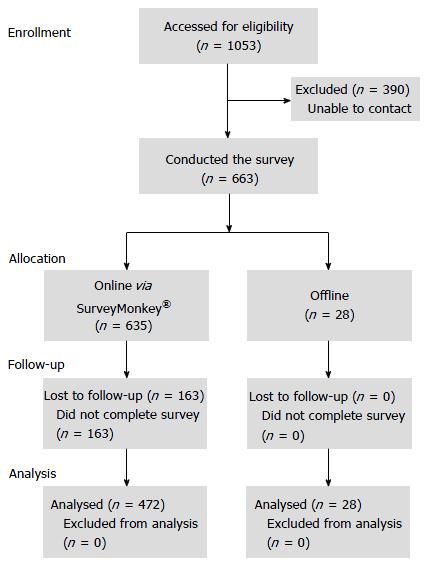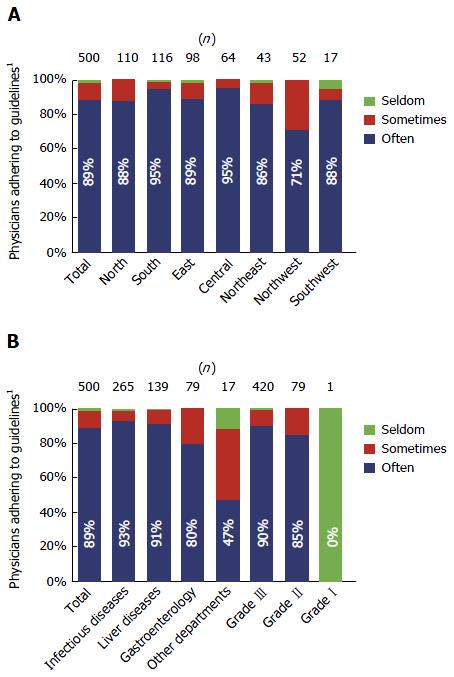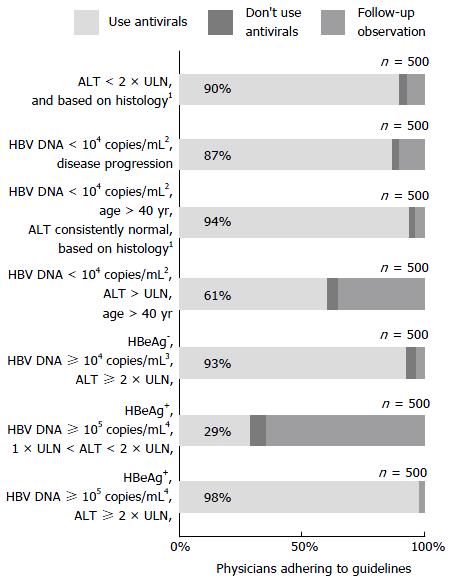Copyright
©The Author(s) 2016.
World J Hepatol. Jun 28, 2016; 8(18): 762-769
Published online Jun 28, 2016. doi: 10.4254/wjh.v8.i18.762
Published online Jun 28, 2016. doi: 10.4254/wjh.v8.i18.762
Figure 1 Participant flow through the study.
Figure 2 Segmentation of physicians.
Segmentation of physicians by number of chronic hepatitis B (CHB) patients seen per month (A) in total, and (B) according to indications stated in the Chinese 2010 CHB guidelines[12]. A: Physicians (n = 500) were asked, “how many CHB patients do you treat per month?”; B: Physicians (n = 500) were asked, “amongst the CHB patients that you treat per month, how many of them are in line with the therapeutic indications as stated in the (Chinese 2010 CHB) guidelines?”.
Figure 3 Physician adherence to the Chinese 2010 chronic hepatitis B guidelines.
Proportion of physicians adhering to Chinese 2010 chronic hepatitis B (CHB) guidelines[12] by (A) region, or (B) by hospital department or grade. 1“Often” defined as > 60% of the time, “sometimes” defined as > 30% to < 60% of the time and “seldom” defined as < 30% of the time.
Figure 4 Physician familiarity with various indications for antiviral medication.
Physician familiarity with the different indications for antiviral medication as described in the Chinese chronic hepatitis B (CHB) guidelines[12] is depicted here. The various indications are listed on the left. Physicians were asked, “does antiviral medication apply to the following cases?” and the proportion of physicians who would consider antivirals, no antivirals, and follow-up for each indication, is depicted in each horizontal bar. According to the Chinese 2010 CHB guidelines, general indications for antiviral treatment include: (1) hepatitis B e antigen (HBeAg)-positive and hepatitis B virus (HBV) DNA ≥ 105 copies/mL, or HBeAg-negative and HBV DNA ≥ 104 copies/mL; (2) alanine aminotransferase (ALT) ≥ 2 × upper limit of normal (ULN); or (3) ALT < 2 × ULN, but hepatic histology show Knodell histology activity index (HAI) ≥ 4, inflammation necrosis grade ≥ 2, or fibrosis stage ≥ 2. If HBV DNA is consistently positive but the above general indications cannot be reached, then antiviral treatment should be considered under the following circumstances: (1) ALT > ULN and age > 40 years; (2) ALT consistently normal and age > 40 years (can be closely monitored, but liver biopsy is recommended; antiviral treatment is indicated when Knodell HAI ≥ 4, or inflammation necrosis grade ≥ 2, or fibrosis stage ≥ 2); or (3) evidence of disease progression following dynamic observation (hepatic histology examination is recommended and antiviral treatment should be administered as necessary). For the distractor (HBeAg-positive, HBV DNA ≥ 105 copies/mL, 1 × ULN < ALT < 2 × ULN), liver biopsy tests are also needed to determine whether antiviral treatment is required. 1Hepatic histology shows Knodell HAI ≥ 4, or inflammatory necrosis grade ≥ 2, or fibrosis stage ≥ 2; 2HBV DNA < 104 copies/mL was considered HBV positive; 3Equivalent to 2000 IU/mL; 4Equivalent to 20000 IU/mL.
- Citation: Wei L, Jia JD, Weng XH, Dou XG, Jiang JJ, Tang H, Ning Q, Dai QQ, Li RQ, Liu J. Treating chronic hepatitis B virus: Chinese physicians’ awareness of the 2010 guidelines. World J Hepatol 2016; 8(18): 762-769
- URL: https://www.wjgnet.com/1948-5182/full/v8/i18/762.htm
- DOI: https://dx.doi.org/10.4254/wjh.v8.i18.762












